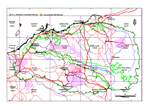Click on images
to enlarge


Photographer: B.R. Maslin

Photographer: B.R. Maslin

Photographer: B.R. Maslin

Photographer: B.R. Maslin
Botanical name
Acacia adoxa var. adoxa x spondylophylla
Description
Dense, ±rounded sub- shrubs 0.3-0.4 m tall and spreading to about 1 m across, slightly sticky-resinous (resin sometimes with a slight curry odour but not as strong-smelling as in A. spondylophylla). Branchlets with rather dense, short, straight, spreading or slightly reflexed hairs. Phyllodes arranged in whorls (5-15 phyllodes per whorl), flattened to sub-terete, 3-8 mm long, about 0.5 mm wide, somewhat finely longitudinally wrinkled when dry (smooth when fresh), rather wide-spreading to ascending, straight to shallowly incurved and sometimes slightly recurved at the tips, with hairs similar to those on branchlets except slightly shorter, dull greenish; longitudinal nerves indistinct; rather abruptly narrowed at apex into a very short, non-spiny point. Inflorescences simple; peduncles 6-22 mm long, hairs similar to those on branchlets; heads globular, large (about 10 mm in diameter when fresh, 7-8 mm when dry), golden, 25-35-flowered. Flowers 5-merous; calyx dissected into triangular lobes; petals obscurely striate and sparsely or densely minutely spreading-hairy. Pods (immature) narrowly obloid, flat but rounded over seeds along midline, not constricted between seeds, 3-4 cm long, 8-10 mm wide, straight to shallowly curved, not or slightly sticky, glabrous. Seeds (immature) transversely placed in the pods.
Characteristic features
Low, spreading, slightly sticky-resinous sub- shrubs 0.3-0.4 m tall, sometimes with a slight curry odour. Branchlets and phyllodes invested with short, straight, spreading or slightly retrorse hairs. Phyllodes arranged in whorls (5-15 per whorl), 3-8 mm long, rather wide-spreading, dull greenish. Heads large (about 10 mm in diameter when fresh), on long peduncles (6-22 mm); petals obscurely striate, sparsely to densely hairy.
Distribution and ecology
This hybrid is seeming rare and confined to the Pilbara region in northwest Western Australia. There are confirmed records in the Ophthalmia Range west of Newman, and from near Nullagine. At both localities it occurred at low frequencies in populations where the two parents were common. Grows in skeletal soil on low rocky hills.
Flowering and fruiting period
Flowering plants have been collected from mid-July to mid-October, at which time mature buds and young pods were also present on the plants.
Taxonomy
The hybrid status of the plants described here are based on field observations and morphological criteria derived from an examination of specimens collected.
Affinities
In the field this putative hybrid is most readily distinguished from the parents by its dull greenish phyllodes which are intermediate in colour between the smoky blue-grey of A. adoxa var. adoxa and the bright green of A. spondylophylla. The phyllode length and orientation, the degree of resinosity and the petal striations, are also intermediate between the parents; plants of this hybrid sometimes have a faint curry odour (not as strong-smelling as in A. spondylophylla).
Conservation status
There is insufficient information at present concerning this entity to justify including it on the Department of Environment and Conservation's Declared Rare and Priority Flora List.
